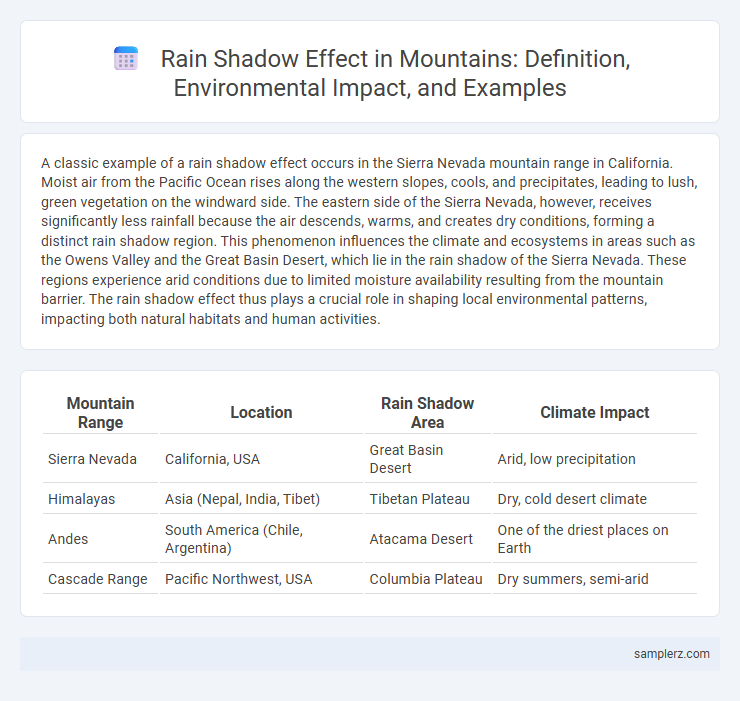A classic example of a rain shadow effect occurs in the Sierra Nevada mountain range in California. Moist air from the Pacific Ocean rises along the western slopes, cools, and precipitates, leading to lush, green vegetation on the windward side. The eastern side of the Sierra Nevada, however, receives significantly less rainfall because the air descends, warms, and creates dry conditions, forming a distinct rain shadow region. This phenomenon influences the climate and ecosystems in areas such as the Owens Valley and the Great Basin Desert, which lie in the rain shadow of the Sierra Nevada. These regions experience arid conditions due to limited moisture availability resulting from the mountain barrier. The rain shadow effect thus plays a crucial role in shaping local environmental patterns, impacting both natural habitats and human activities.
Table of Comparison
| Mountain Range | Location | Rain Shadow Area | Climate Impact |
|---|---|---|---|
| Sierra Nevada | California, USA | Great Basin Desert | Arid, low precipitation |
| Himalayas | Asia (Nepal, India, Tibet) | Tibetan Plateau | Dry, cold desert climate |
| Andes | South America (Chile, Argentina) | Atacama Desert | One of the driest places on Earth |
| Cascade Range | Pacific Northwest, USA | Columbia Plateau | Dry summers, semi-arid |
Understanding the Rain Shadow Effect in Mountain Regions
The rain shadow effect occurs when moist air ascends a mountain range, causing precipitation on the windward side and leaving the leeward side arid. The Sierra Nevada in California is a prime example, where prevailing westerly winds drop rain on the western slopes, creating lush forests, while the eastern slopes experience dry conditions typical of a desert. This phenomenon significantly influences local ecosystems, water resources, and agricultural patterns in mountain regions worldwide.
Key Characteristics of Rain Shadow Areas
Rain shadow areas form on the leeward side of mountain ranges where moist air ascends the windward slopes, cools, and precipitates, leaving dry descending air in the shadow zone. These regions typically exhibit low humidity, sparse vegetation, and reduced precipitation, often resulting in semi-arid or desert climates. Notable examples include the eastern slopes of the Sierra Nevada in California and the Patagonian region behind the Andes Mountains.
Famous Rain Shadow Examples Around the World
The Cascade Range in the Pacific Northwest creates a prominent rain shadow effect, resulting in the dry eastern Washington region. Similarly, the Sierra Nevada Mountains cause a rain shadow that contributes to the arid conditions of California's Owens Valley. The Himalayas form another major rain shadow, leading to the desert climate of the Tibetan Plateau on their leeward side.
The Himalayas and Their Rain Shadow Impact
The Himalayas create a significant rain shadow effect on the Tibetan Plateau, blocking moist monsoon winds from reaching the region and resulting in arid conditions. This orographic barrier causes heavy rainfall on the southern slopes while the northern areas remain dry and desert-like. The rain shadow significantly influences the climate and biodiversity across these contrasting zones.
The Sierra Nevada Mountains’ Rain Shadow Zone
The Sierra Nevada Mountains create a prominent rain shadow zone where moist air from the Pacific Ocean rises and cools, dropping precipitation on the western slopes and leaving the eastern side arid. This climatic effect results in significantly lower rainfall in areas like Nevada's Great Basin Desert, contributing to its dry environment. The rain shadow phenomenon influences local ecosystems, vegetation patterns, and water availability in this region.
Atacama Desert: The Driest Rain Shadow Example
The Atacama Desert in northern Chile is the driest rain shadow region on Earth, created by the Andes Mountains blocking moist Pacific air. This mountain barrier causes significant precipitation on the windward side but results in extreme aridity on the leeward side, where annual rainfall averages less than 1 millimeter. The unique topography and atmospheric conditions of this rain shadow environment contribute to the Atacama Desert's hyper-arid climate and sparse vegetation.
The Cascade Range and Pacific Northwest Rain Shadows
The Cascade Range creates a significant rain shadow effect in the Pacific Northwest, where moist air from the Pacific Ocean rises, cools, and precipitates on the windward western slopes, resulting in lush temperate rainforests. On the leeward eastern side, descending dry air causes arid conditions, exemplified by regions such as eastern Washington and Oregon. This climatic phenomenon influences local ecosystems, agricultural patterns, and water resources throughout the area.
Andes Mountains: Creating South American Rain Shadows
The Andes Mountains create significant rain shadow effects across South America, characterized by arid regions on their leeward sides, such as the Atacama Desert, one of the driest places on Earth. Moist air from the Atlantic Ocean rises along the eastern slopes, cooling and releasing precipitation before descending as dry air on the western slopes. This rain shadow effect profoundly influences the biodiversity, climate patterns, and water availability throughout countries like Chile, Argentina, and Peru.
Ecological Consequences of Rain Shadows in Mountains
Rain shadows in mountain regions create arid conditions on the leeward side, leading to distinct ecological zones with reduced biodiversity compared to windward slopes. These dry environments often result in specialized plant and animal species adapted to limited water availability, influencing local ecosystems and soil composition. The sharp contrast between lush windward forests and barren leeward areas highlights the significant role rain shadows play in shaping mountain ecology and habitat distribution.
Human Adaptation in Rain Shadow Environments
Communities living in rain shadow regions, such as those east of the Sierra Nevada, have adapted by developing advanced water conservation techniques like rainwater harvesting and efficient irrigation systems. Agricultural practices frequently shift towards drought-resistant crops like millet and sorghum to cope with limited precipitation. Infrastructure design often incorporates materials and methods that maximize shade and reduce water loss, ensuring sustainable living in these arid mountain environments.

example of rain shadow in mountain Infographic
 samplerz.com
samplerz.com